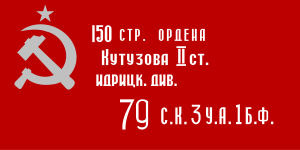You can help expand this article with text translated from the corresponding article in Russian. (May 2022) Click [show] for important translation instructions.
|


The Soviet Banner of Victory (Russian: Знамя Победы, romanized: Znamya Pobedy) was the banner raised by the Red Army soldiers on the Reichstag building in Berlin on 1 May 1945,[1] the day after Adolf Hitler committed suicide. It was raised by three Soviet soldiers: Ukrainian Alexei Berest, Russian Mikhail Yegorov, and Georgian Meliton Kantaria.
The Victory Banner, made under battlefield conditions, is the official symbol of the victory of the Soviet Union over Nazi Germany during the Second World War. It is also one of the national treasures of Russia. The Cyrillic inscription reads:[2]
150 стр. ордена Кутузова II ст. идрицк. див. 79 С. К. 3 У. А. 1 Б. Ф.
Translated and with abbreviations changed to their referents, the flag's writing means:
150th Rifle Order of Kutuzov 2nd class Idritsa Division 79th Rifle Corps 3rd Shock Army 1st Belorussian Front
Although this flag was not the only one to be hoisted on the Reichstag, it was the first one to be raised and was the only survivor of all the "official" flags specially prepared to be raised there.
According to the Law of the Russian Federation, the Banner of Victory is to be stored forever in a place which provides its safety and public availability.
- ^ Федеральный закон от 7 мая 2007 г. № 68-ФЗ «О Знамени Победы» // Собрание законодательства Российской Федерации от 14 мая 2007 г. № 20 ст. 2369 (in Russian)
- ^ Донесение командующего 3-й ударной армией начальнику главного политического управления Красной Армии о бое за Рейхстаг и водружении над ним знамени Победы // militera.lib.ru (in Russian)